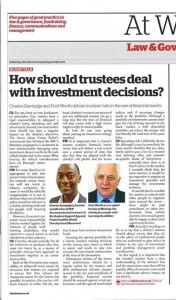On 19 December 2014, the government responded to the consultation on audit and independent examinations for charities, with a “plan to pursue proposals that include increasing the following thresholds from £500,000 to £1 million”. This new threshold will take effect for accounting periods ending or after 31 March 2015 and will affect charities in relation to:
- income threshold at which a charity should have its accounts audited
- aggregate group income threshold at which parent charities should have group accounts audited
- preparation threshold for group accounts
But what does this mean for charities exactly?
Well, for most charities with total income of up to £1,000,000 there is the choice of having an independent examination of their accounts rather than a full audit. The technical view of an independent examination versus an audit is that a statutory auditor is required to a “positive opinion” as to whether or not the statutory accounts give a “true and fair view”.
By contrast, an Independent Examiner forms a “negative opinion” that states (if this is indeed the result of their work) that no evidence of lack of accounting records or compliance of the accounts with those records.
There are other matters that both an audit and independent examination make statements on, and the use of “positive” and “negative” assurance terminology in technical language can be misleading (as if “negative assurance” is somehow a bad thing! It is sometimes helpful to think of the two simply in terms of an audit making a statement that there is evidence to confirm one way or the other, but an Independent Examination stating that there has been no evidence found for lack of…
Benefits of an independent examination
In order to form the positive opinion that is required of the statutory auditor, they need to perform significantly more testing and review than is generally required of an independent examiner, in order to obtain the evidence that supports that opinion.
The “lighter-touch” Independent Examination (IE) is therefore a less onerous alternative for smaller charities, which results in significant savings for them, in two ways:
- Staff time – less time will be spent between the reviewer and staff in order to complete the accounts scrutiny. Staff can in turn use this time on running the charity.
- Fees – typically, an independent examination could cost up to 40% less than audit in actual fees payable by the charity.
As one client put it on hearing the news of an increased threshold:
“this will cut down on costs and the stress that comes with audit scrutiny”
Does an Independent Examination really provide sufficient independent scrutiny?
The Charity Commission has stated in its publication CC31 that “an independent examination is a simpler form of scrutiny than an audit but it still provides trustees, funders, beneficiaries, stakeholders and the public with an assurance that the accounts of the charity have been reviewed by an independent person.”
Whether this level of scrutiny provides sufficient assurance for the particular stakeholder is a matter to be discerned internally by each qualifying charity. However I have found that most stakeholders would appreciate the cost savings and opt for an Independent Examination. And where further assurance is required by a given donor, a grant audit can be arranged for their grant (the cost of which is often build into the grant itself in full).
Other considerations for independent examinations: Which charities are eligible for Independent Examination?
In England and Wales (there are different thresholds for Scotland and Northern Ireland), a charity would be eligible if it passes two sets of tests.
The first set of tests relates to the charity qualifying as a “smaller charity”. This means that:-
For accounting periods ending on or after 31 March 2015, the charity has total annual income not exceeding £1,000,000 (this also applies to aggregate income where it is a group); and (b) the charity has gross assets not exceeding £3,260,000.
A charity would still be considered a small charity if it had gross assets exceeding the asset threshold but where its income is below £250,000. (NB: if gross income is above £250,000 and gross assets exceed £3,260,000, then an audit would be required).
The second set of tests relates to other possible other requirement for a statutory audit. These may be internal, but others may be external. Such requirements include:-
- The governing documents/constitutions of the charity may specify that an ‘audit’ is required (NB: constitutions can be amended if this is considered unnecessary)
- A donor or funder may requires an ‘audit’ (NB: this can be discussed with the donor to lift the requirement and/or to have a grant audit instead)


 The issue of how to make the ‘right’ investment decisions is something that many trustees regularly have to deal with. In a recent article in the Third Sector magazine, I debated this issue with a sector colleague, Fred Worth, co-opted Trustee of Mencap, and have included some of the ideas discussed below.
The issue of how to make the ‘right’ investment decisions is something that many trustees regularly have to deal with. In a recent article in the Third Sector magazine, I debated this issue with a sector colleague, Fred Worth, co-opted Trustee of Mencap, and have included some of the ideas discussed below.